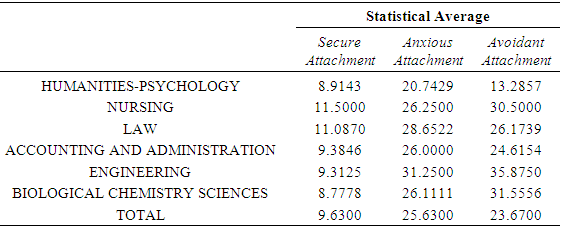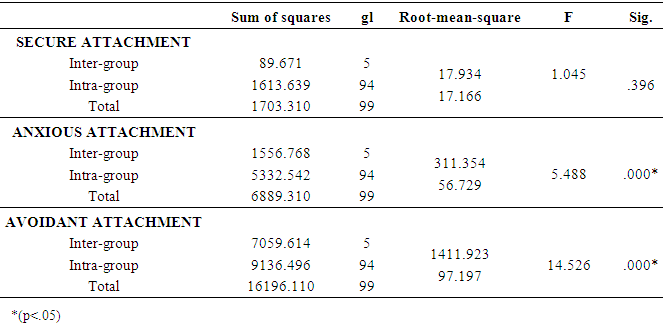-
Paper Information
- Paper Submission
-
Journal Information
- About This Journal
- Editorial Board
- Current Issue
- Archive
- Author Guidelines
- Contact Us
International Journal of Psychology and Behavioral Sciences
p-ISSN: 2163-1948 e-ISSN: 2163-1956
2018; 8(1): 12-16
doi:10.5923/j.ijpbs.20180801.03

Attachment in University Students
Gabriela I. Pérez Aranda, Walter A. Trejo Paat, Carolina G. Rivera Quintana, Sinuhé Estrada Carmona
Faculty of Humanities, Autonomus University of Campeche, México
Correspondence to: Sinuhé Estrada Carmona, Faculty of Humanities, Autonomus University of Campeche, México.
| Email: |  |
Copyright © 2018 Scientific & Academic Publishing. All Rights Reserved.
This work is licensed under the Creative Commons Attribution International License (CC BY).
http://creativecommons.org/licenses/by/4.0/

The aim of this study was to compare the predominant attachment styles of 100 university students (50 men and 50 women) who were in a couple relationship lasting from 2 to 5 years. The instrument used was an adaptation of a scale that evaluates attachment styles (secure attachment, anxious attachment and avoidant attachment) in couple relationships (Márquez, Rivera and Reyes, 2009). Results show no significant differences between the attachment styles in relation to gender, however, positive correlations were found between anxious and avoidant attachment. In addition, anxious attachment style predominates in both male and female participants, with a minor difference also presenting significant scores in the avoidant attachment style.
Keywords: Attachment, Safe attachment, Avoidant attachment, Anxious attachment, Couple relationships, Gender
Cite this paper: Gabriela I. Pérez Aranda, Walter A. Trejo Paat, Carolina G. Rivera Quintana, Sinuhé Estrada Carmona, Attachment in University Students, International Journal of Psychology and Behavioral Sciences, Vol. 8 No. 1, 2018, pp. 12-16. doi: 10.5923/j.ijpbs.20180801.03.
Article Outline
1. Introduction
- In a first approach to the measurement of attachment styles [1] say that the Mexican couple tends to cling to their spouse in six ways: Realistic-rational, anguish-pain reactions, safe, dependent-insecure, independent-distant and distant-affective, in this regard, Díaz-Loving said that in Mexico the most frequent styles reported were the realistic-rational style and the least frequent was the distant-affective one.Another study [3] indicate that Mexican women are more characterized by the anxious / worried style.According to [8] Bowlby defined attachment behavior as any form of behavior that results in the achievement or preservation of proximity to another clearly identified individual who is considered better able to face the world.It was previously mentioned that the attachment style is a fairly stable variable throughout life, this is because it is governed by the principle of primacy, which indicates that the first experiences have a stronger and more lasting effect on the subsequent ones.The individual differences in the establishment of couple relationships will be very determined by the representational model constructed from childhood experiences.Sánchez [8] mentioned that adults often have the same person as an attachment figure, friend, spouse, lover, companion of children's upbringing, etc. On the other hand, the way in which an attachment style works also depends to some extent on the attachment style of the person with whom it interacts; Therefore, even if two people have similar attachment styles, intimacy relationships do not live in the same way if the members of their respective partners are different.Melero [7] mentions that attachment means the emotional bond that people build and maintain with other people that are highly significant at the relational level, with practical derivations in the way of understanding those relationships, of feeling them and acting accordingly.There are three basic types of attachment; secure attachment, which is established by the effectiveness of the object of attachment, these are people who trust that their parental figures will be accessible and cooperative if they are in an adverse or frightening situation; anxious attachment is characterized by a chronic anxiety related to the object of attachment, insecurity of whether the parental figure will be accessible or sensitive or will help when needed; avoidant attachment is characterized by a defensive reaction and rejection towards the object of attachment, as a way to protect oneself, avoiding the caregiver and exhibiting signs of separation with anguish.In this way, this study aimed to compare the predominant attachment styles of men and women university students who were in a relationship between 2 and 5 years, this was done through the application of an attachment scale; analyzing the three attachment styles mentioned previously (secure attachment, anxious attachment and avoidant attachment).
2. Method
- The methodological paradigm is quantitative. The scope of the study is comparative and correlational, as well as transactional.The instrumentation of the styles of attachment used was developed by [6] taking into account the items with greater factorial weight in previous studies (Ojeda, 1988, 2003), the translation-retranslation of the romantic attachment instruments of Brennan, Clark and Shaver (1998), Simpson, Rholes and Philips (1996); and the Bartholomew and Horowitz (1992) vignettes validated in Mexico by García (2007) and Sánchez (2000) and the Alonso-Arbiol scale (2000, in Yárnoz, Alonso-Arbiol, Plazaola and Sainz de Murieta, 2001).In this way, attachment styles in different Mexican populations have been validated methodologically in the last 10 years.
2.1. Objective
- To compare the predominant attachment styles in college men and women in a relationship.
2.2. Scenario
- This study was carried out at the Autonomous University of Campeche, México.
2.3. Participants
- A non-probabilistic sample was taken for the convenience of 100 undergraduate students of the Autonomous University of Campeche, 50 men and 50 women, between 18 and 26 years old, with an average age of 20 years, who are in a relationship between 2 to 5 years of courtship. The selected degrees were 6: Nursing, Accounting and Administration, Law, Humanities-Psychology, Engineering and Biological Chemistry Sciences.
2.4. Instrument
- The instrument used in our research is a scale that evaluates attachment styles (secure attachment, anxious attachment, avoidant attachment) in relationships, this is an adaptation made to the Mexican population by [6]. This instrument was adapted for a greater reliability, leaving a total of 18 regents of the 21 that were originally within the scale; 6 correspond to the style of secure attachment, 6 to the style of anxious attachment and 6 to the style of avoidant attachment. The response format is Likert type with 7 options that ranges from "totally agree" to "totally disagree". The reliability of the instrument is high since it obtained a .879 in the Cronbach's alpha test.
2.5. Procedure
- The pertinent permits were obtained to access the 6 faculties belonging to the Autonomous University of Campeche. More than 100 attachment style scales were applied, each containing a demographic record where data were requested that included the gender of the participant, gender of the couple, age, faculty, semester, engagement time, and occupation. The data obtained was captured in a database and finally the following analyzes were made through the SPSS program version 18: Cronbach alpha test, student t test, contingency analysis, analysis of variance (One Way Anova), analysis of variance post oc HSD of Tukey and analysis of correlations.
3. Results
- Below are the results obtained from the application of the attachment styles instrument in university men and women who were in a couple relationship that exceeded or had two years of duration.56% of the male population obtained scores indicating that their predominant attachment style is the anxious attachment style, in the same way the majority of the female population with a total of 60% obtained results that indicate the predominance of said attachment style, as a result it is obtained that 58% of the total population obtained scores that indicate that their predominant attachment style is the anxious one, while the less frequent attachment style is secure attachment, present only in 2% of the population.The bilateral significances (secure attachment .720, anxious attachment .953 and avoidant attachment .774) of the 3 attachment styles are greater than alpha 0.05, so they are not significant, the means of the attachment styles are statistically equal or in another way no statistically significant differences were found between the samples in relation to their statistical average.In the secure attachment style, the nursing faculty obtained the highest average with 11.5000. It is also shown that the engineering faculty obtained the highest average in both the anxious attachment style with 31.2500, and in the avoidant attachment style with 35.8750.
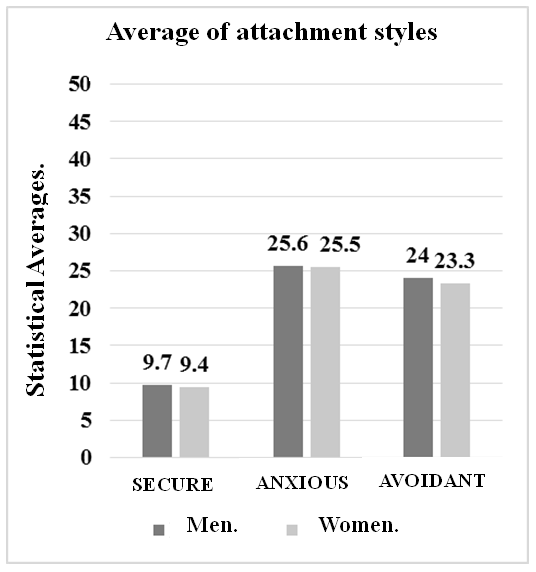 | Figure 1. Statistical average of attachment styles in men and women |
|
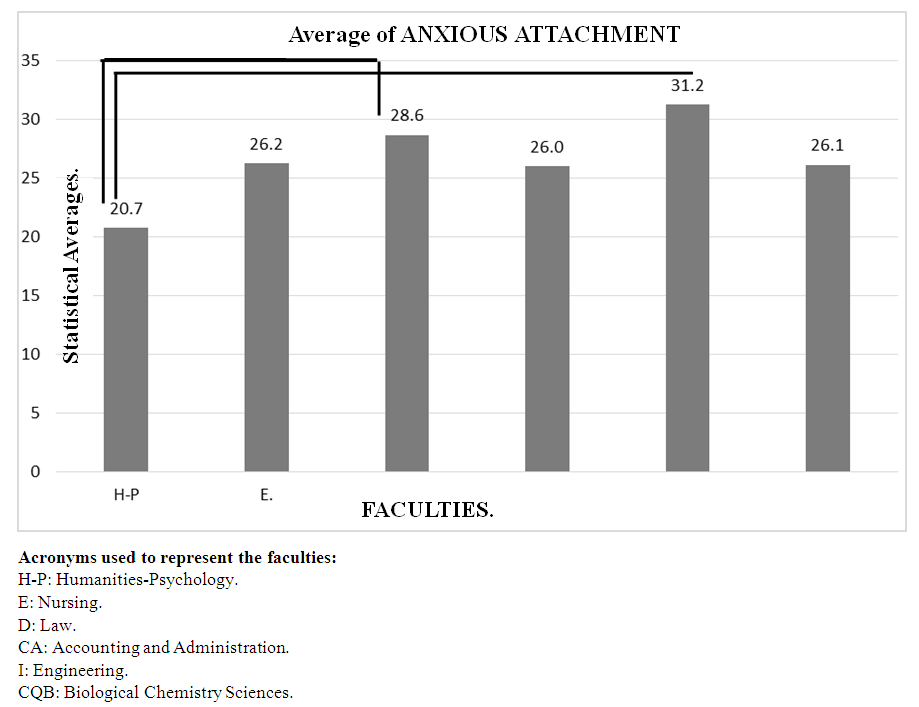 | Figure 2. Analysis of variance post oc HSD of Tukey |
|
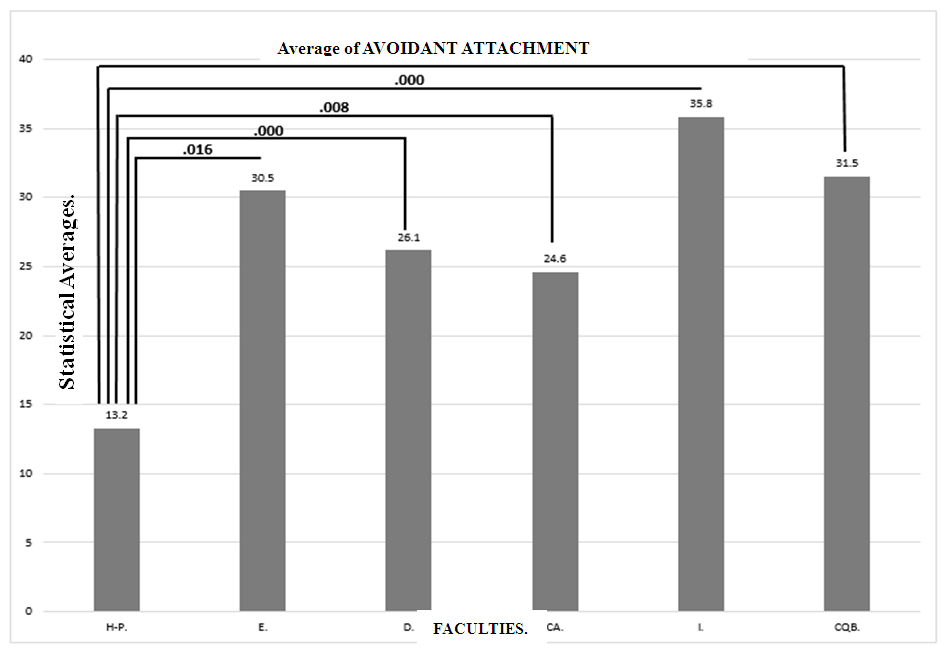 | Figure 3. Analysis of variance post oc HSD of Tukey |
|
4. Discussion and Conclusions
- The main objective of this study was to compare in the evaluated sample the predominant attachment styles in college men and women in a couple relationship. In this aspect, it can be affirmed that according to the analyzes carried out, the results do not show significant differences between the attachment styles that are presented in the population related to gender, however, the correlations show that while the scores increase in the style of Anxious attachment also increases in avoidant attachment style, hence there are similar scores of both styles in the population, the results obtained differ with those presented by [9] who concluded that the majority of the population had a type of attachment sure, which was predominant in men, while in women on the other hand they present an anxious attachment style and therefore are more dependent.In both men and women participating in our study the style of anxious attachment predominates; significant scores are also presented in the avoidant attachment style with a minor difference, this may be due to the ideological changes presented by the new generations due to the equality of gender and freedom in love relationships. Thus, in the analyzed sample the hypothesis that suggested that in a couple's relationship there are significant differences between the attachment styles in college male and female is not met, this is consistent with what was suggested by [5] in his studies, when he states that beyond the differences it can be said that the existence of attachment styles in adult life has been confirmed very similar to those of childhood and that they have been quite successfully related to the different love styles that have been found in couples.On the other hand, other authors [4] found similar results to those obtained in our research, these results show a high number of insecure children represented by those who do not find their emotional needs met (avoidant attachment), such similar results may result from changing socio-economic conditions, since now parents must work to meet the physiological needs of their children, but at the same time neglecting to a greater or lesser degree the satisfaction of emotional needs that in turn form an important part of the development of attachment styles that they will set the pattern in the way individuals interact during adult life. This coincides with Bowlby's approach to attachment styles that are built from childhood to adulthood.Regarding the differences in the types of attachment by faculties it was found that the faculty of engineering is the one that has higher scores in the styles of anxious and avoidant attachment while the faculty of psychology has the lowest scores in said styles, it was expected that the psychology faculty had significant scores in the style of secure attachment due to the extensive management on interpersonal relationships that is handled in said degree, however, this makes us clarify that the contents taught in these faculties are not significant in the attachment styles presented by the participants. These results indicate that the type of academic profile does not guarantee a healthy relationship; since the attachment relationship is formed in early life experiences. Similarly, studies related to gender equality [2] showed significant differences in the faculties of engineering and psychology.In this research, the identification of predominant attachment styles among university students in Campeche was achieved. The hypothesis that there were significant differences between attachment styles between men and women was also discarded.To conclude, it is pointed out that the data found here show the importance of continuing to investigate attachment in relationships, as it is variant information that can be found over the years and it would be interesting to discover what kind of affective bonds are forming in the following generations and how they will be manifested in their adult life.Future studies may include variables such as communication, personality types, relationship time, even sexual and religious aspects that in traditional Mexican culture can contribute to the analysis of attachment.
ACKNOWLEDGEMENTS
- Special thanks to Br. Octavio Cacho Álvarez for helping on the translation of the manuscript.Also thanks to the administration staff of the faculties of the university that participate in the study.
 Abstract
Abstract Reference
Reference Full-Text PDF
Full-Text PDF Full-text HTML
Full-text HTML